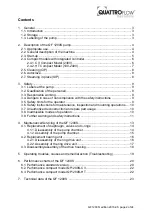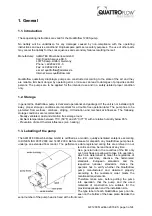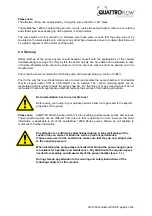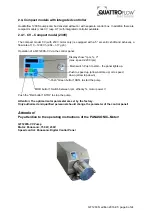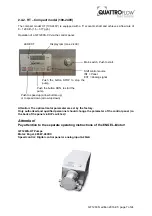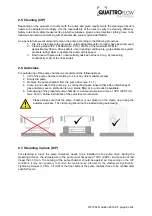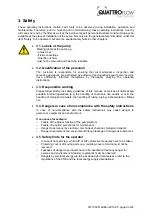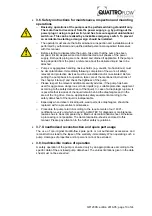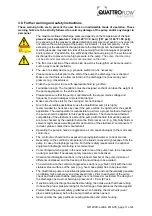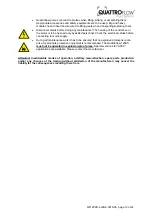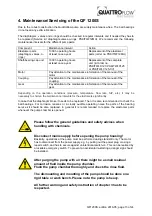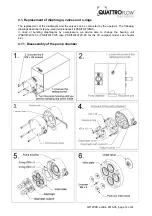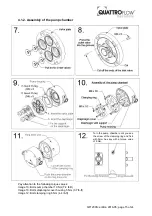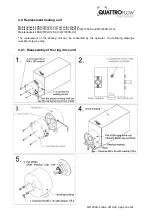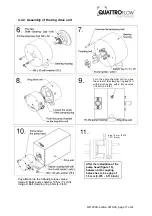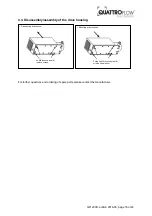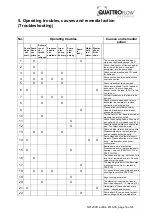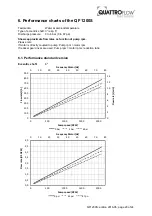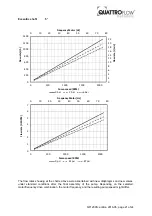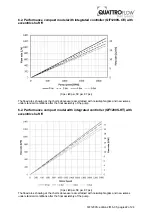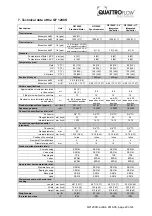
QF1200S; edition 2016-05; page 11 of 24
3.9. Further warning and safety instructions
These warning hints are to prevent the user from an inadmissible mode of operation. These
warning hints are to be strictly followed to avoid any damage of the pump and/or any danger to
personnel
The maximum allowed discharge pressure depends on the temperature of the fluid:
pmax at room temperature = 6 bar (>40°C = 4 bar) ) [=87 psi (>104°F = 58 psi)]
.
An exceeding of the maximum allowed discharge pressure must avoid in any case (do
not remove the warning sign at the pump). As a result – if only temporarily – of an
exceeding of the allowed discharge pressure the diaphragm can be damaged. The
resulting leakage may lead to a loss of the pumping fluid and damages of properties
and/or persons. Pay attention to a sufficiently dimensioned piping on the suction and
discharge line to prevent a too high pressure in the pump.
The pump chamber may
not be set under pressure when it is not mounted on the drive.
The free cross section of the suction side as well as the length must be measured in
such a way to avoid cavitation.
The use of a safety device (e.g. pressure switch) can be necessary..
Please make sure that prior to the start of the pump the discharge line is checked.
Make sure that there is no flow restriction in the discharge line to avoid any over
pressure (e.g. closed valve).
Flush the pump prior to use with appropriate fluid (e.g. buffer).
Foundation design: The foundation must be designed so that it can take the weight of
the pump aggregate on the entire surface. .
Please make sure that the pump is operated with the proper mains voltage and
frequency to avoid damages and electrical danger.
Make sure that the slots for the cooling air are not blocked.
Due to the versatile possibilities to use the Quattroflow pump it is highly
recommended to check case by case if the pump will be the right tool for the specific
application. The user/operator is responsible to perform a proper method of testing if
the pump should be applied for his specific application. The chemical and thermal
compatibility of the elastomeric parts of the pump with the fluid that will be pumped
are to be checked by the operator before the first process run.
E.g. Oily, fatty fluids or
solvents might cause a swelling and/or destruction of the elastomeric components. If
in doubt, please contact the manufacturer!
Operating the pump in humid or aggressive air can cause damages to the motor and
control box.
The control box should not be exposed to spray/splash water or to heat sources.
Depending on the conditions of operation, the liquid conveyed might escape from the
pump in case of a diaphragm rupture. For further safety requirements the optional
equipment diaphragm monitoring is recommended.
Pools of liquid which appear in the near outer area of the pump have to be inspected
on danger potential, if necessary safety measures are to be taken.
Chemical and biological reactions in the product chamber of the pump (mixture of
different substances) and the freezing of the liquid have to be avoided.
To avoid corrosion the contact of aggressive solutions (e.g. NaCl, HCl) with the outer
stainless steel surfaces of the pump (e.g. hood, base plate) has to be prevented.
The Quattroflow pump is a positive displacement pump and can theoretically generate
an infinitely high pressure even at low speed (rpm). Prior to each start of the pump
check and make sure that the discharge line is not closed or restricted. The design of
the discharge line must not build up a pressure of > 6 bar (87 psi).
If suction and/or discharge line are flexible tubing, then make sure that these tubing
do have the proper pressure rating for the full range of temperatures that are applied.
Please follow the general safety guidelines when handling chemical fluids (wear
gloves and/or glasses) before the pump chamber will be opened.
Never operate the pump without coupling protection and motor housing.
6


